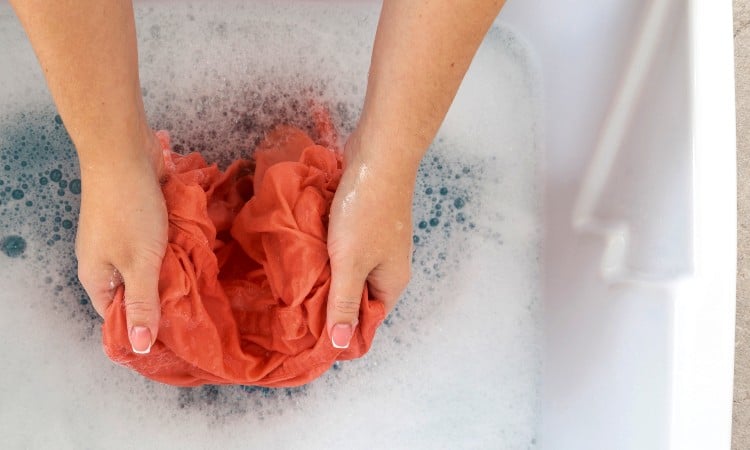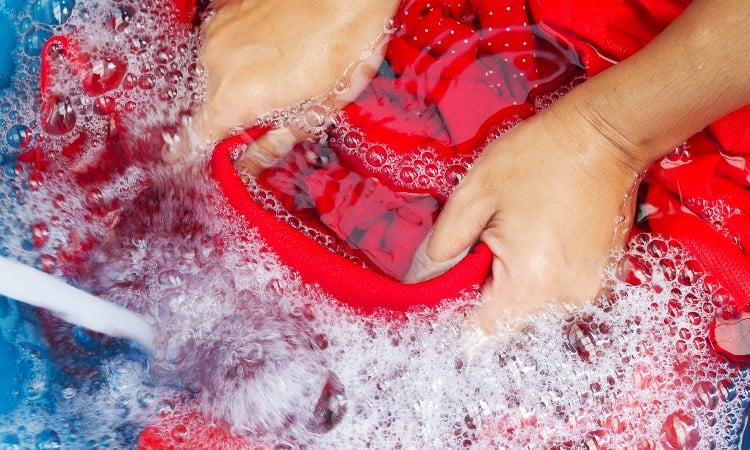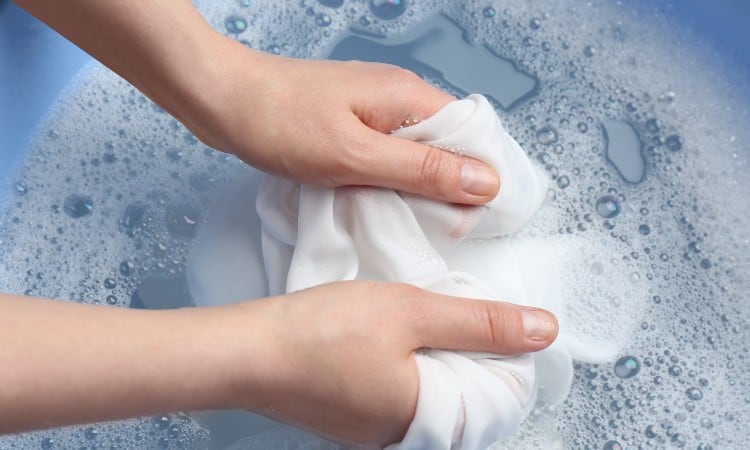Most people have hand washed clothes at some point in their lives. Sometimes it’s just one item that needs to be cleaned; at others, it’s a delicate item that won’t hold up to the cycle of machine washing. If you have an entire load of laundry and no access to a washing machine, have you ever wondered how to wash clothes in the bathtub?
Washing clothes in the bathtub is an easy method of washing a small or full-sized load of laundry by hand. Like hand washing items in the sink, you can fill the bathtub with water, add your desired detergent, agitate to wash and follow by rinsing. Clothes can then be line or tumble-dried.
In this article, we will explain the best method for washing clothes in the bathtub, whether at home or on the road. We also include a step-by-step guide and some helpful tips for general handwashing. Finally, we will review a few alternate methods of washing clothes without a traditional washing machine.

Quick Navigation
- Can You Wash Clothes in the Bathtub?
- How to Wash Clothes in Bathtub: Step-by-Step Guide
- Washing Delicate Items
- Is Hand Washing Clothes Effective?
- Tips for Hand Washing Clothes
- Drying Hand Washed Clothes
- Washing Clothes While Traveling – in a Hotel Bathtub
- Other Ways to Wash Clothes Without a Washer
- Can “Dry Clean” Items be Hand Washed in a Bathtub?
- Conclusion
Can You Wash Clothes in the Bathtub?
There are plenty of reasons you may not be able to use a washing machine, perhaps the power is out or you live in an apartment with no laundry room. Whatever the reason, it’s always a good idea to know how you will wash your clothes when the need arises. It may come as a surprise, but a bathtub provides a practical solution.
A bathtub is a large bin with a built-in water source and drain. While it can’t agitate on its own, there’s not much more you will need to get your clothes fresh and clean – maybe just a bit of elbow grease.
How to Wash Clothes in Bathtub: Step-by-Step Guide

Before you begin, you’ll want to give the tub a thorough wash. The bathtub is known to contain germs and soap residue that you don’t want getting on your clothing. Give the tub and surrounding area a good scrub with an all-purpose cleaner and rinse well with warm water.
Most liquid or powdered laundry detergents used in a machine will also work for washing clothes in a bathtub. Remember that a liquid detergent will dissolve more readily than a powdered one. A mild detergent is advised if you use bare hands to agitate the laundry – it will be gentler on the skin. Some heavy detergents can be difficult to rinse from clothes, and you can use a lot more water to rinse them completely. Plant-based detergents are also a great choice – they will be gentle on the skin during washing and better for the environment and wastewater systems.
If the reason you are washing by hand is that you will be washing delicate items, then a delicates detergent should be used. Soak is a handy no-rinse laundry soap that is ideal for hand washing garments, and Woolite has been a popular brand on the market for years. Specific for wool or cashmere items, Eucalan Fine Fabric Wash is a great choice – it contains lanolin to protect and condition the wool fibers and also does not require rinsing!
Your choice of laundry detergent and the bathtub itself are all you need to get your clothes clean. Additional optional items include a washing board if you have especially dirty items and tall rubber gloves if you want to be easier on the hands.
1. Clean Your Tub
Use an all-purpose cleaner to thoroughly scrub the inside of the tub and the surrounding area. Rinse well with warm water, making sure to eliminate all soap residue.
2. Check Care Labels
It is always important to check the labels inside of garments to ensure that the washing method used is compatible with the items being washed.
3. Sort Your Laundry
Just as you would separate lights from darks for washing in the machine, your laundry should be sorted before washing a load in the bathtub.
4. Plug the Drain
Make sure that you have a tight-fitting plug to avoid water leaking while the clothes are soaking.
5. Adjust the Water Temperature
The temperature should be set according to the care labels of the clothes that will be washed – generally cold/cool water for a mixed load. If washing sheets, towels, or something more heavily soiled, warm water may be necessary. Just make sure to refer back to the care labels first.
6. Add the Detergent
Detergent should be added while filling the tub. This will help the detergent dissolve and be evenly distributed throughout the water before the clothes are added. If a load of laundry is a similar size to what you would put into a washing machine, use the same amount of detergent. If you are working with a smaller load, half the amount of soap can be used. Filling the tub completely to the top with water isn’t necessary. Just enough water to cover the amount of clothes that will be washed will do
7. Add Your Clothes to the Bathtub
After adding the clothes to the tub, swirl gently to ensure everything is wet and submerged. Allow the laundry to soak for a minimum of 10 minutes, ideally closer to 30 minutes. Soaking will help loosen dirt and debris stuck between the clothing fibers.
8. Wash the Clothes
Using your hands, with or without rubber gloves, you can now begin to agitate the clothing. If working with extra tough stains, pull out the washing board or simply rub the fibers of cloth together with your hands until the stain comes loose. A *clean* rubber plunger can be used here to help with washing if you don’t want to get your hands wet. Alternatively, you can jump in and stomp the laundry with your feet. This should take from 5 to 10 minutes, depending on the soil level.
9. Rinse the Laundry
Drain the soapy water. It’s best to squeeze as much soapy water from the garments as possible and then remove the items to either the sink or an empty bin nearby. This way, all soap residues can be rinsed from the bathtub before it’s refilled. Once the dirty water is drained, return the clothes to the bathtub and refill them with clean water. Swirl and agitate, or stomp the clothing again. Then drain and repeat as necessary until all the detergent is rinsed from the clothes.
10. Squeeze Water from Clothing
Be gentle, squeeze each item to remove as much water as possible. It is important to never wring clothes when wet! This can stretch and damage the fibers of the garment. After squeezing, you can roll items tightly in a dry towel to remove excess water. Replace towels as they become wet.
Dry Your Clothes
Dry your clothes by the means listed on the care label.
Washing Delicate Items
A delicate item can refer to anything made from delicate or fragile material – such as silk or lace- or an item with a stiff structure like a bra. Sweaters made from wool or that can snag easily can also be categorized as delicate. Most of these items can be damaged by the aggressive cycle of a washing machine or prematurely deteriorate with exposure to full-strength laundry detergents.
Hand washing delicate items takes a bit of care but can be achieved similarly to that explained above. First, fill a sink or basin with cool water – if a large load of delicate items needs to be washed, this can be done in the bathtub. Next, add the appropriate amount of delicates detergent. Swirl to make sure that each item is completely wet and allow to soak for 10 to 30 minutes. Agitating aggressively is not necessary when washing delicates as you don’t want to damage the structure of the item. Drain the soapy water and rinse only if necessary. Read the instructions for the detergent being used – many delicates detergents don’t require rinsing, so you can move right on to gently squeezing excess water from the garment. To remove the most water, try rolling the item in a dry towel and then drying as recommended per the care label.
Without Detergent
What if you don’t have any laundry detergent on hand? Don’t fret, there are several other soapy options – likely already lying around the house – that will do a perfectly suitable job of cleaning your clothes.
- Hand soap, body wash or shampoo offer good alternatives to laundry detergent – and will probably leave them smelling even better!
- Baking soda and vinegar – or lemon juice – will do the job of removing unwanted smells and getting those clothes clean. Add half a cup of baking soda to the wash water and a half cup of vinegar when you rinse. If you don’t have vinegar on hand, lemon juice can be swapped out in the same amount. Voila!
- Dish soap can be used on dark or colored clothing – most experts recommend Dawn – if you don’t have any other options. Remember, it’s highly concentrated, so a little goes a long way. This is less of a concern when hand washing, but dish soap should never be used in high-efficiency washing machines!
- Bar soap can be used in place of laundry detergent if you’re in a bind. Shred off a small amount from the bar and toss it with the washing water. Bar soap is also concentrated and can be tough to rinse out thoroughly, so this is another situation where less is more.
Is Hand Washing Clothes Effective?
Hand washing clothes is a very effective method for cleaning clothes! It is energy efficient since it uses no electricity and can even save water if you only wash a few items – instead of unnecessarily filling an entire machine. It is also a great way to extend the life of those delicate items and any garment that is washed by hand. It might take a bit more time and effort, but hand-washed clothes will come out just as clean, and you can feel satisfied that you burned a few more calories.
Tips for Hand Washing Clothes
- Read care labels, just as you would for washing by machine.
- Sort clothes – wash darks with darks and lights with lights.
- Fill your basin with water and dissolve detergent before adding clothes.
- Allow the clothing to soak for a minimum of 10 minutes, though 30 minutes is ideal.
- Never wring out clothes! Wringing water from clothes can cause damage to the fibers – fibers are especially susceptible to stretching when wet.
- Roll just-washed items in a dry towel to remove excess water gently and effectively.
- Hang or lay flat to dry.
Drying Hand Washed Clothes
Once you’ve finished hand washing your clothes, and as much water has been removed, they still need to be dried. Anything with a care label that reads “Tumble Dry” can be tossed in the dryer. If you are hand washing in the first place to avoid using a machine, there are plenty of ways that clothes can be air dried.
After washing the laundry in the bathtub, items can easily be hung directly over the shower curtain rod – a bonus here is that the tub will help catch some of the drips! An outdoor clothesline is ideal for drying – there’s nothing better than folding freshly washed clothes that have dried in the fresh air. Travel clotheslines are a great option and super convenient since they are portable and can be used both indoors and out. A foldable drying rack can also provide plenty of space for drying clothes and doesn’t have to be a permanent fixture in your home.
Washing Clothes While Traveling – in a Hotel Bathtub

If you’re traveling and realize you need to wash your clothes, doing so right in your hotel room is easier than you may have thought! If you spilled on a shirt at dinner and have one item to wash, you can do so in the sink. Fill with water, add soap, soak, wash and rinse the item.
If you’re on a longer trip and want to wash a whole load of laundry, the bathtub in a hotel will do just as good a job as any. Follow the same method described in the step-by-step guide above. If doing laundry wasn’t part of the itinerary and you don’t have access to laundry detergent, the body wash or shampoo provided by the hotel will act as a suitable substitute. Even a bar of hotel soap will get your clothes efficiently clean. Just crape a small amount of soap into the wash water before adding the clothes, and remember, a little goes a long way!
Other Ways to Wash Clothes Without a Washer
Besides washing clothes in a bathtub, many other methods can be used to hand wash laundry. Clothes can easily be washed in any sink, bucket or tub or in a washboard basin – which is a plastic bin with a built-in washboard for scrubbing. Fill the bin with soapy water and scrub away!
The Laundry POD resembles a salad spinner, but for your clothes…This device is designed to help you easily wash clothes by hand with much less effort. You can wash, spin, drain, and rinse from this portable – and completely manual – contraption in just minutes! No electricity is required, and a similar size to a 5-gallon bucket is a great option for small spaces.
There are many available portable washing machines on the market and in various sizes. Most of these machines can connect right to a sink or bathtub faucet, and utilizing a hose, drain this way as well. These machines usually require a power source and can take up some space, but they are an affordable and economical choice if looking for something other than a traditional machine.
A portable wash bag is a minimalist option – especially good for camping or, if you know, you’ll need to wash something while traveling. The item that needs cleaning is placed in this durable, waterproof bag, then filled with minimal water and soap. It’s then squished and squeezed until the clothes are clean. Empty and rinse the same way as washing and you have laundry while fully on the go! The downside of this method is that the capacity is minimal.
Can “Dry Clean” Items be Hand Washed in a Bathtub?
As emphasized, it is important to read care labels before washing any garment, especially when dealing with delicate ones. But what if you want to wash an item labeled “Dry Clean?” There is a distinct difference between those labeled “Dry Clean” and those labeled “Dry Clean Only.” You should never attempt to wet wash the latter. “Dry Clean Only” garments should always be taken to the dry cleaner to avoid being ruined.
Some items labeled as “Dry Clean” are labeled so because they are delicate or have a stiff structure. These items can become misshapen or easily snagged and are not necessarily labeled “Dry Clean” because the fibers cannot become wet. If you’d like to attempt to hand wash an item labeled “Dry Clean,” know that you are doing so with at least a small amount of risk. Before plunging right in, test a very small area with a drop of water to check for color fastness. Gently rub the area, and allow the spot to dry completely. Observe the spot to ensure no ring or discoloration is left before moving on. Many items will do fine being hand washed, but others – such as structured items like blazers – will do better being spot cleaned.
Conclusion
Hand washing clothes is a method used widely across the world. It is an effective method that gets clothes just as clean as a machine does. Hand washing can come with many added benefits as well. It saves energy and water and can extend the life of your favorite garments. Now that you know so many useful methods for hand washing clothes – from bathtub to wash bag – will you try one next time the laundry bin is full?